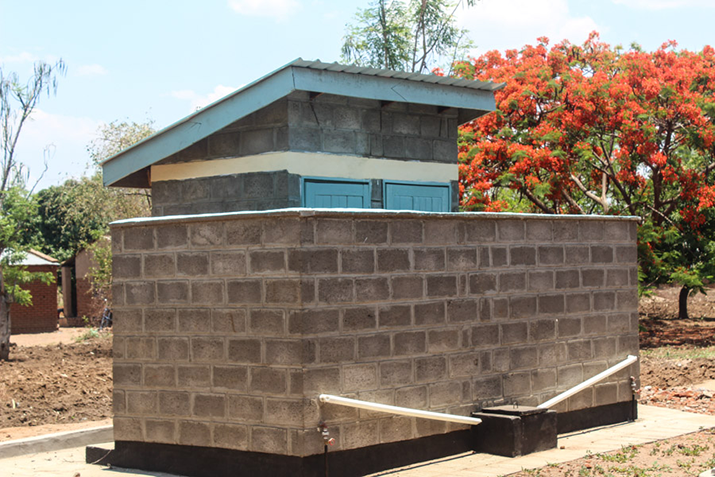A Community Restores Safe Sanitary Facilities for Expectant Mothers
A Community Restores Safe Sanitary Facilities for Expectant Mothers
![[Patuma Mustafa (left) meets with members of Kalembo Health Center Management Committee.] {Photo credit: Rejoice Phiri/MSH}](https://msh.org/wp-content/uploads/2020/11/img_1514-2_715px.png)
Namaseko, nine months pregnant, was taking an afternoon nap at Kalembo Health Center in Balaka, Malawi when she suddenly needed a bathroom. As she carefully got up, she remembered that there was no toilet in the maternity wing; she would have to walk to the further side of the health center to use the pit latrines near the outpatient department. The latrines were full, but they were the only toilets at the facility. As she walked further, Namaseko thought she felt contractions but ignored it, intent on making it to her destination.
Patuma Mustafa, chairperson for Kalembo Health Center Management Committee, recalls hearing shouting outside of where she and her colleagues were meeting. “We heard women screaming. As I checked to see what was going on, someone shouted that a woman was giving birth in the pit latrines. We ran carrying chitenges [a cloth or garment] to rescue her. When we got there, she had already delivered her baby. Thankfully she had managed to catch her baby before it fell into the toilet.” And that was not the first time this happened here, explains Mustafa, “we have rescued several women who gave birth at those latrines. All because the maternity wing did not have a toilet. Can you imagine? As if that is not enough, even the placenta pit was full. It was a pathetic situation.”
Many people face increased risk of infection by seeking care in health facilities that lack even basic necessities in Malawi. Kalembo Health Center is no different. Yet, it is one of the district’s most reliable health centers. Kalembo Health Center serves almost 45,000 people from surrounding villages and delivers nearly 18 babies every single day.
But with no toilets for their maternity wing, pregnant women have to use the outpatient department’s dilapidated toilet. Even more upsetting, the pit used to dispose of placentas after birth had filled up. There was a pungent smell that filled the entire health facility and dogs were literally dragging waste to the maternity rooms.
“We were so concerned for the safety of our expectant mothers and their unborn children. In addition, the toilets were so full…it was just not healthy at all. As Kalembo Health Centre management, we decided we had to close the health center indefinitely. We were putting people’s lives in danger,” explained Tamanda Yotamu, a staff member at Kalembo Health Center.
But once closed, the community and district health office went into panic mode. The community still came to seek services. Yet, no one was there to assist them, so they just sat around. Most of them did not have the means to travel to the next health center 10 km away. Balaka’s district health office, which had not acted before, in spite of numerous complaints from the health center management team, now took notice. They sat down with the traditional leaders of the community to ask for help in building the much-needed latrines, since the district health office did not have funds to do it. Unfortunately, these leaders could only afford to dig a pit. They had not been able to find adequate materials to fully build new toilets. And that is where the USAID ONSE Health Activity came in. ONSE, which supports the government of Malawi in its efforts to reduce maternal, newborn, and child morbidity and mortality, has been working to improve water, sanitation, and hygiene (WASH) at the community and health facility-level as water-borne diseases and hospital-acquired infections are a challenge in the country.
According to Jack Mabvuka, District Coordinator for ONSE in Balaka district, during a visit aimed at informing areas for quality improvement and galvanizing ownership and local support, “We were conducting a scorecard session in this community and one of the issues that kept cropping up was the lack of toilets at the Balaka facility, particularly in the maternity wing.” After the ONSE team carried out their assessment, they agreed to support the construction of two ventilated improved pit (VIP) latrines blocks, each containing two holes each. It was a group effort: ONSE procured the building materials, technical oversight, and the cost of labor, the district health office provided labor, and the community provided oversight of the work and contributed some materials as needed, such as sand. Completed in September 2020, the VIP latrines include hand rails and a seat for disabled persons and pregnant women and also handwashing basins, which are disability friendly.

“The toilets that ONSE built at Kalembo were unlike any other pit latrines we have built anywhere under the same program, due to scarcity of land at this health care facility. The latrines have a desludging chamber at the back, allowing sludge to be removed and the pit to be reused. In this way, the issue of where to construct another VIP latrine will not arise. This is ONSE’s innovation to deal with the scarcity at the Kalembo Health Care Facility,” explained Berlings Banda, WASH advisor for ONSE.
Closing the health center for a week felt like years for members of this community, who could not praise ONSE enough. The community now appreciates adequate sanitation and toilets as basic necessities that promote the health of everyone. In addition, working together with ONSE and the health center management committee, the people of Kalembo, and their expectant mothers, now have a proper sanitary facility.
Related content:
Frontline Health Workers Call for Improved WASH to Fight COVID-19